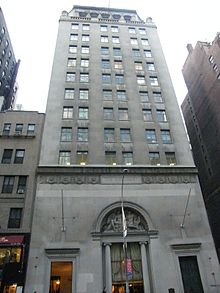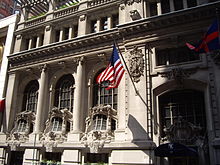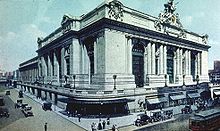- Warren and Wetmore
-
Warren and Wetmore was an architecture firm in New York City. It was a partnership between Whitney Warren (1864–1943) and Charles Wetmore (1866–1941), that had one of the most extensive practices of its time and was known for the designing of large hotels.
Whitney Warren was a cousin of the Vanderbilts and spent ten years at the École des Beaux Arts. There he met fellow architecture student Emmanuel Louis Masqueray, who would, in 1897, join the Warren and Wetmore firm. He began practice in New York City in 1887.
Warren's partner, Charles D. Wetmore, was a lawyer by training. Their society connections led to commissions for clubs, private estates, hotels and terminal buildings, including the New York Central office building, the Chelsea docks, the Ritz-Carlton, Biltmore, Commodore, and Ambassador Hotels. They were the preferred architects for Vanderbilt's New York Central Railroad.
The firm's most important work by far is the Grand Central Terminal in New York City, completed in 1913 in association with Reed and Stem. Warren and Wetmore were involved in a number of related hotels in the surrounding "Terminal City".
Whitney Warren retired in 1931 but occasionally served as consultant. Warren took particular pride in his design of the reconstructed library at the Catholic University of Leuven, finished in 1928, which carried the controversial inscription Furore Teutonico Diruta: Dono Americano Restituta ("Destroyed by German fury, restored by American generosity") on the facade. The library was largely destroyed by German forces again in 1940.
The architectural records of the firm are held by the Dept. of Drawings & Archives at the Avery Architectural and Fine Arts Library, Columbia University.
Other commissions
 Steinway Hall on 57th Street, New York City, 1925
Steinway Hall on 57th Street, New York City, 1925
Among the firm's other commissions were:
- the Racquet House at the Tuxedo Club, Tuxedo Park, New York, 1890-1900
- Westmorly Court , part of Adams House at Harvard University 1898-1902
- the New York Yacht Club, 1899
- 49 East 52nd Street, Vanderbilt guest house, New York City, 1908
- Union Station (Winnipeg), Manitoba, Canada, 1911
- Union Station, Houston, Texas 1911 (Now a part of Minute Maid Park)
- Aeolian Hall (New York), 1912
- the Helmsley Building, originally the New York Central Building, part of the Grand Central Terminal complex, 1913
- the unfinished Michigan Central Station, Detroit, Michigan, 1913, also with Reed and Stem
- Packard Manor, Chautauqua, New York- A summer home for William Doud Packard, 1915
- the Texas Company (Texaco) Building, Houston, Texas, 1915
- 927 Fifth Avenue, New York City, a cooperative apartment house, 1917
- The Commodore Hotel, now the Grand Hyatt Hotel, part of "Terminal City", 1920
- The New York Biltmore Hotel, also part of "Terminal City"
- the Crown Building, formerly the Heckscher Building, New York City, 1921
- the Providence Biltmore Hotel, Providence, Rhode Island, 1922
- the Mayflower Hotel, Washington, D.C., 1922, with Robert F. Beresford
- Steinway Hall on 57th Street, New York City, 1925
- Royal Hawaiian Hotel, Honolulu, Hawaii, 1927
- Norwood Gardens terrace homes, 36th St., Astoria, New York, planned development by W&W architect Walter Hopkins, 1928
- Asbury Park Convention Hall, 1923, and the adjoining Paramount Theatre, 1930
- Ritz-Carlton, Atlantic City, 1921
- the Chelsea Piers
- 903 Park Avenue, a Bing & Bing building.
 New York Yacht Club, 44th Street, New York City
New York Yacht Club, 44th Street, New York City
Bibliography
- The Architecture of Warren & Wetmore by Peter Pennoyer and Anne Walker, published by W. W. Norton (New York, 2006). ISBN 0-393-73162-6
External links
- Warren and Wetmore at New York Architecture Images
- high-resolution photographs of Warren and Wetmore's interiors at the New York Yacht Club
- Warren & Wetmore architectural drawings and photographs, 1889-1938. Held in the Dept. of Drawings & Archives, Avery Architectural and Fine Arts Library, Columbia University.
Categories:- Warren and Wetmore buildings
- Defunct architecture firms based in New York City
Wikimedia Foundation. 2010.



